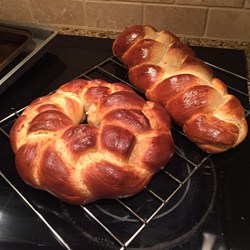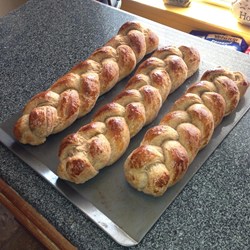  |
ChallahThis "double loaf" (in Hebrew: lechem mishneh) commemorates the manna that fell from the heavens when the Israelites wandered in the desert for forty years after the Exodus from Egypt. The manna did not fall on Sabbath or holidays; instead, a double portion would fall the day before the holiday or sabbath. On Shabbat, the two challahs placed on our festive tables represent the double-portion of manna that fell on Friday, the heavenly bread that fed Jewish people during their 40 years in the desert. The word “cake” is a translation of the Hebrew word “challah.” The offering or portion of challah that was given to the priests (kohanim) was called the mitzvah of “hafrashat challah” – separating the challah. See Numbers 15:18-21 for the first mention of the bread. In the days of the Temple in Jerusalem, Jews were told to separate 1/24th of the doughs and give it to the kohanim every Shabbat. The breads are covered on the table by a decorative challah cover or a white napkin, which represents the dew that collected on the manna in the morning. Poppy and sesame seeds sprinkled on the bread also symbolize the manna that fell from heaven.
"Traditional egg bread for the Jewish Sabbath. You can add 1 cup raisins or golden raisins to the dough just before shaping and then make the loafs into round braids for Rosh Hashanah." The dough used for making the cakelike challah can be formed into a variety of shapes, including braids, rolls and knots. The ingredients go together easily, and the bread looks beautiful when served. For the dinner table, you can form the dough into a pair of small braids or into a single large, spectacular one. The aroma of baking challah and the sight of the traditional loaves revives every Jewish soul with the reminder that Shabbat is nearby.
|